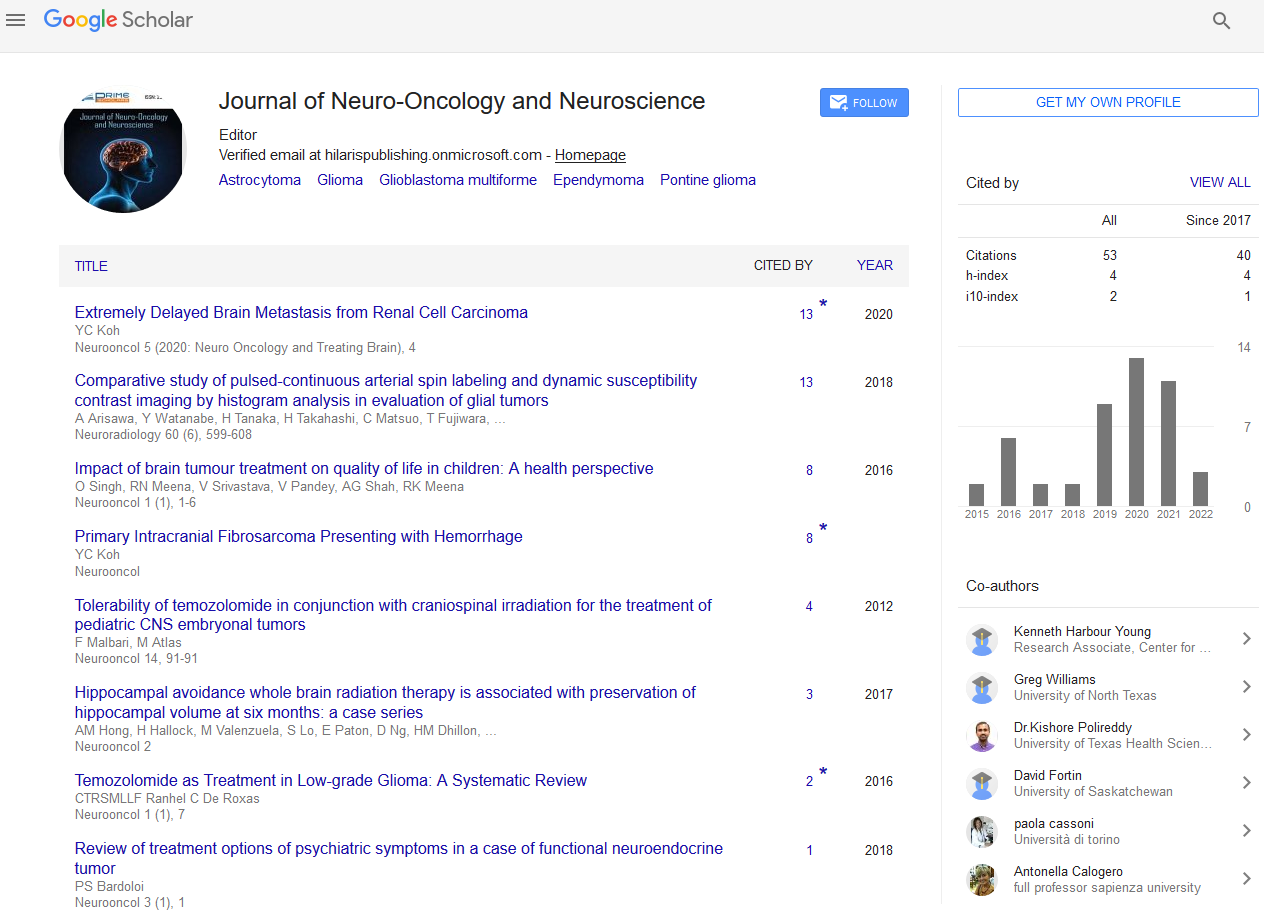Short Communication - (2024) Volume 9, Issue 4
Neuroprotective Strategies During Radiation and Chemotherapy for Brain Tumors
Steve Laurent*
Department of Sciences, University of California Irvine, United States of America
*Correspondence:
Steve Laurent,
Department of Sciences, University of California Irvine,
United States of America,
Email:
Received: 02-Dec-2024, Manuscript No. IPJNO-24-22245;
Editor assigned: 04-Dec-2024, Pre QC No. IPJNO-24-22245 (PQ);
Reviewed: 18-Dec-2024, QC No. IPJNO-24-22245;
Revised: 23-Dec-2024, Manuscript No. IPJNO-24-22245 (R);
Published:
30-Dec-2024, DOI: 10.21767/2572-0376.9.4.35
Introduction
Brain tumors, among the most challenging malignancies to
treat, often require aggressive therapies such as radiation
and chemotherapy. While these modalities are essential for
controlling tumor growth, they also pose significant risks to
healthy brain tissue, leading to neurocognitive decline, fatigue,
and long-term neurological complications. Neuroprotection,
aimed at preserving healthy neural structures and functions
during treatment, has become a critical focus in improving the
quality of life for brain tumor patients. Emerging strategies,
from advanced delivery techniques to pharmacological
interventions, offer promising avenues to mitigate these
adverse effects. Radiation therapy, while effective at targeting
tumor cells, often affects surrounding healthy brain tissue.
Memory, attention, and executive function can be impaired
due to damage to the hippocampus and other critical regions.
Radiation can disrupt the integrity of white matter tracts,
leading to long-term neurological deficits. Pro-inflammatory
cytokines released during treatment exacerbate damage to the
brain’s microenvironment. Certain chemotherapeutic agents,
such as temozolomide, can cross the Blood-Brain Barrier
(BBB), affecting both tumor and normal brain cells. Side effects
include “chemo brain,” characterized by impaired cognition,
and cumulative neurotoxic effects with prolonged treatment.
Description
Proton Beam Therapy (PBT) delivers radiation more precisely,
reducing exposure to surrounding healthy tissues and
minimizing neurotoxic effects. Stereotactic Radio Surgery (SRS)
high-dose radiation is focused on the tumor with sub-millimeter
accuracy, sparing adjacent healthy brain regions. Intensity-
Modulated Radiation Therapy (IMRT) adjusts radiation dose
delivery to conform closely to the tumor’s shape, preserving
critical structures like the hippocampus. Medications such
as memantine, an NMDA receptor antagonist, have shown
efficacy in reducing cognitive decline during and after
radiation therapy. Dexamethasone and other corticosteroids
mitigate neuro inflammation, although long-term use must be
carefully managed due to side effects. Agents that promote
neuronal growth and repair, such as erythropoietin, are being
investigated for their neuroprotective potential. Advances in
BBB modulation allow for targeted delivery of chemotherapy to
tumors while protecting healthy brain tissue. Techniques such
as focused ultrasound and nanoparticle-based drug delivery
are promising. Emerging radiotherapy approaches specifically
aim to spare the hippocampus, a region vital for memory and
learning. Studies have demonstrated reduced cognitive decline
with these techniques without compromising tumor control.
Foods rich in antioxidants, such as berries and green leafy
vegetables, combat oxidative stress induced by treatments.
Regular physical activity improves neuroplasticity and reduces
fatigue and cognitive impairment associated with therapy.
Post-treatment neuro rehabilitation, including cognitive
exercises and memory training, helps restore lost functions and
improves patients’ quality of life. Immunotherapies, including
immune checkpoint inhibitors and CAR T-cell therapy, have
the potential to target tumors with fewer off-target effects
compared to traditional treatments. Combining these with
neuroprotective strategies may enhance outcomes. AI models
are being developed to predict individual patient responses
to therapy, enabling personalized neuroprotective strategies
tailored to minimize neurotoxicity while maintaining treatment
efficacy [1-4].
Conclusion
The evolution of neuroprotective strategies during radiation and chemotherapy marks a significant step forward in brain tumor
care. By integrating advanced technologies, pharmacological
agents, and lifestyle modifications, it is possible to mitigate the
neurotoxic effects of treatment and enhance patients’ overall
well-being. The ultimate goal is a holistic approach that not
only extends survival but also ensures a better quality of life for
brain tumor patients, making neuroprotection an indispensable
aspect of modern oncology. Protecting healthy brain tissue
without compromising tumor control requires precise calibration
of interventions. Advanced therapies like proton beam therapy
remain expensive and are not widely available. Incorporating
new strategies into established treatment regimens requires
rigorous clinical validation. Research should prioritize longterm
studies to evaluate the effectiveness of neuroprotective
interventions and their impact on survival and quality of life.
Acknowledgement
None.
Conflict Of Interest
The author declares there is no conflict of interest in publishing
this article.
References
- Parsons MW, Peters KB, Floyd SR, Brown P, Wefel JS (2021) Preservation of neurocognitive function in the treatment of brain metastases. Neurooncol Adv 3(Suppl 5):v96-v107.
[Crossref] [Google Scholar] [PubMed]
- Shaw MG, Ball DL (2013) Treatment of brain metastases in lung cancer: strategies to avoid/reduce late complications of whole brain radiation therapy. Curr Treat Options Oncol 14(4):553-67.
[Crossref] [Google Scholar] [PubMed]
- Winter SF, Jo J, Schiff D, Dietrich J (2022) Central nervous system complications among oncology patients. Hematol Oncol Clin North Am 36(1):217-236.
[Crossref] [Google Scholar] [PubMed]
- Dye NB, Gondi V, Mehta MP (2015) Strategies for preservation of memory function in patients with brain metastases. Chin Clin Oncol 4(2):24.
[Crossref] [Google Scholar] [PubMed]
Citation: Laurent S (2024) Neuroprotective Strategies during Radiation and Chemotherapy for Brain Tumors. Neurooncol. 9:35.
Copyright: © 2024 Laurent S. This is an open-access article distributed under the terms of the Creative Commons Attribution License, which permits unrestricted use, distribution, and reproduction in any medium, provided the original author and source are credited.

